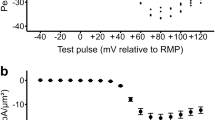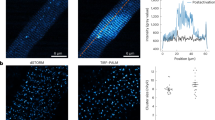Abstract
Rapid calcium efflux from the sarcoplasmic reticulum (SR) is a necessary step in excitation–contraction coupling in skeletal muscle and is thought to be mediated by a calcium channel1–3. Calcium efflux has been studied in fragmented SR vesicles by radioisotope efflux and fluorescence measurements. Several laboratories have reported that adenine nucleotides can stimulate calcium efflux from SR4–7. In recent reports, Ca2+ release with a first-order rate constant as high as 100 s−1 has been observed for nucleotide-stimulated Ca2+ release from SR vesicles8,9. Also, radioisotope efflux was blocked by Mg2+ and micromolar concentrations of the polycationic dye, ruthenium red1–7. These high rates of transport are difficult to reconcile with a mechanism other than passive diffusion through a nucleotide-activated ‘calcium release channel’7–9. Using the fusion technique for inserting SR proteins into planar lipid bilayers10, we report here single-channel recordings of calcium release channels from purified ‘heavy’ SR membranes. Channels have been identified on the basis of their activation by adenine nucleotides, blockade by ruthenium red, and selectivity for divalent cations. Surprisingly, the channel studied here exhibits an unusually large conductance of 170 pS in 50 mM Ba2+ while still being capable of discriminating against monovalent cations by a permeability ratio, P(Ba)/P(Cs) = 11.4.
This is a preview of subscription content, access via your institution
Access options
Subscribe to this journal
Receive 51 print issues and online access
$199.00 per year
only $3.90 per issue
Buy this article
- Purchase on Springer Link
- Instant access to full article PDF
Prices may be subject to local taxes which are calculated during checkout
Similar content being viewed by others
References
Ebashi, A. A. Rev. Physiol. 38, 293–313 (1976).
Endo, M. Physiol. Rev. 57, 71–108 (1977).
Bianchi, C. P. & Frank, G. B. Can. J. Physiol. Pharmac. 60, 415–588 (1982).
Ogawa, Y. & Ebashi, S. J. Biochem., Tokyo 80, 1149–1157 (1976).
Endo, M. & Kitazawa, O. Proc. Japan Acad. 52, 599 (1976).
Morii, H. & Tonomura, Y. J. Biochem., Tokyo 93, 1271–1285 (1983).
Meissner, G. J. biol. Chem. 259, 2365–2374 (1984).
Nagasaki, K. & Kasai, M. J. Biochem., Tokyo 94, 1101–1109 (1983).
Meissner, G., Darling, E. & Eveleth, J. J. Biochemistry (in the press).
Miller, C. & Racker, E. J. Membrane Biol. 30, 283–300 (1976).
Meissner, G. Molec. cell. Biochem. 55, 65–82 (1983).
Miller, C. J. Membrane Biol. 40, 1–23 (1978).
Kushmerick, M. J. in Handbook of Physiology Section 10 (eds Peachey, L. D., Adrian, R. H. & Geiger, S. R.) 189–236 (American Physiological Society, Bethesda, Maryland, (1983).
Baylor, S. M., Chandler, W. K. & Marshall, M. W. J. Physiol, Lond. 344, 625–666 (1983).
Gupta, R. K. & Moore, R. D. J. biol. Chem. 255, 3987–3993 (1980).
Lee, K. S. & Tsien, R. W. J. Physiol., Lond. 354, 253–272 (1984).
Coronado, R., Rosenberg, R. & Miller, C. J. gen. Physiol 76, 425–446 (1980).
Nelson, M. T., French, R. J. & Krueger, B. K. Nature 308, 77–80 (1984).
Affolter, H. & Coronado, R. Biophys. J. (in the press).
Fabiato, A. J. gen. Physiol 78, 457–497 (1981).
Author information
Authors and Affiliations
Rights and permissions
About this article
Cite this article
Smith, J., Coronado, R. & Meissner, G. Sarcoplasmic reticulum contains adenine nucleotide-activated calcium channels. Nature 316, 446–449 (1985). https://doi.org/10.1038/316446a0
Received:
Accepted:
Issue Date:
DOI: https://doi.org/10.1038/316446a0
This article is cited by
-
Isolated Cardiac Ryanodine Receptor Function Varies Between Mammals
The Journal of Membrane Biology (2024)
-
Function of a mutant ryanodine receptor (T4709M) linked to congenital myopathy
Scientific Reports (2023)
-
Ryanodine receptor 1-related disorders: an historical perspective and proposal for a unified nomenclature
Skeletal Muscle (2020)
-
Structural factors that determine the ability of adenosine and related compounds to activate the cardiac ryanodine receptor
British Journal of Pharmacology (2000)
Comments
By submitting a comment you agree to abide by our Terms and Community Guidelines. If you find something abusive or that does not comply with our terms or guidelines please flag it as inappropriate.



